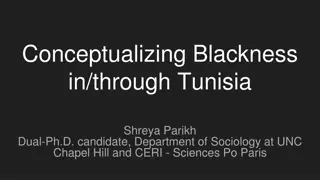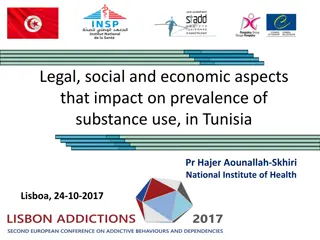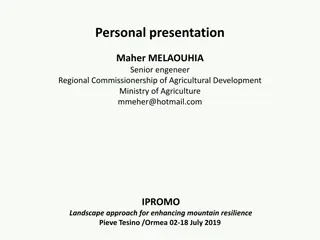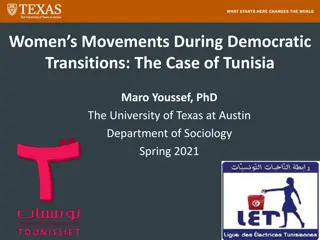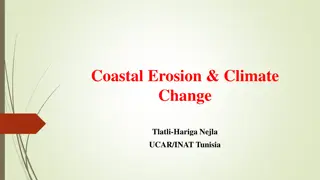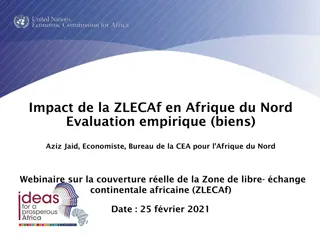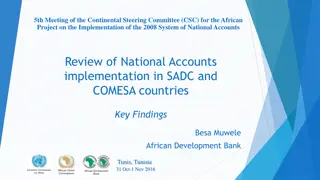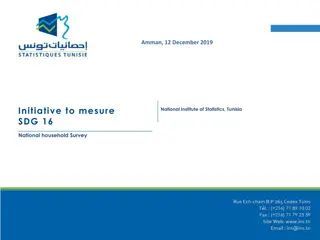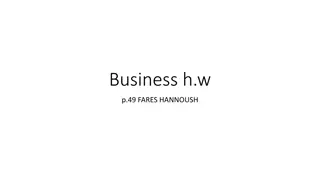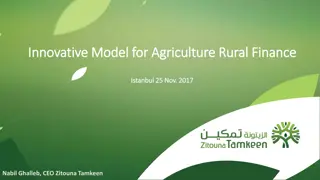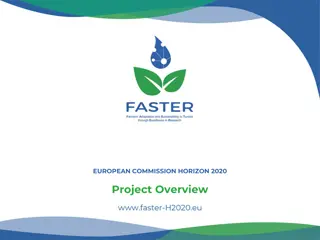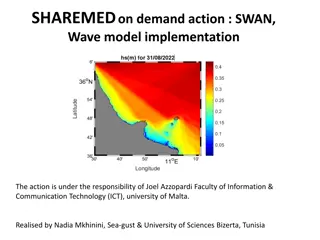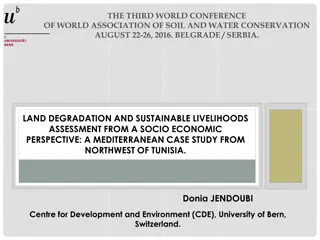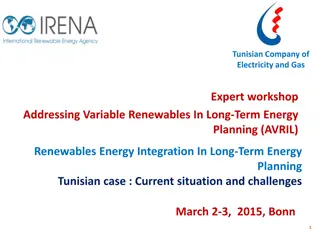
Tunisian Fuel Economy Case Study
"Explore the fuel economy and consumption patterns in Tunisia through a detailed case study conducted by the Center for Environment and Development in the Arab region and Europe. The study delves into factors impacting vehicle energy efficiency, standards set by the European Union and the USA, driving cycles, and limitations in data collection. Discover insights into LDV sales and macro indicators of motorization and urbanization rates in Tunisia."
Uploaded on | 1 Views
Download Presentation

Please find below an Image/Link to download the presentation.
The content on the website is provided AS IS for your information and personal use only. It may not be sold, licensed, or shared on other websites without obtaining consent from the author. If you encounter any issues during the download, it is possible that the publisher has removed the file from their server.
You are allowed to download the files provided on this website for personal or commercial use, subject to the condition that they are used lawfully. All files are the property of their respective owners.
The content on the website is provided AS IS for your information and personal use only. It may not be sold, licensed, or shared on other websites without obtaining consent from the author.
E N D
Presentation Transcript
Fuel Economy/Consumptio n Tunisian Case study Center for Environment and Development For The Arab region and Europe.
Fuel Economy/Consumption Fuel economy (Miles per Gallon) A measure of maximum distance covered by a vehicle per unit of fuel Fuel consumption (Liter per/ 100 km) Amount of fuel saved in lower ranges of MPG higher than those in higher ranges Consumer convenience
Vehicle Energy Efficiency Engine Losses (friction &pump) Aerodynamics & Tires Transmission Terrain Balancing shafts Bore-to-stroke ratio Weight& Fuel
Standards European Union Entire fleet based on mass of a vehicle Sliding scale application of standards Tightening regulations Overlooking technology USA First standards: determined solely by production level Modified Standards: Size based accounting for sales levels. Sole reliance on vehicle size
Driving cycle Enforcement agency Test figures presented by manufacturers Cycle based on local conditions: driving patterns and behavior , road types and elevations levels, etc. CAF , NEDC, Japanese and South Korean .
Approach and limitations GFEi definition of LDVs Sales of new LDVs in the study years. Data obtained from manufacturers through an automotive markets consultant Official figures for co2 emissions and fuel economy/consumption are used based on NEDC Data was not obtained for 1% of new LDVs. Parallel market sales were not obtained
Total Number of Vehicles on the Road
LDVs Sales 90000 80000 70000 60000 Number of Vehicles 50000 40000 30000 20000 10000 0 2009 2012 2013 LDV sales Morocco
Tunisian Macro Indicators Motorization rates (Vehicles per 1000 inhabitants): 121-124 much higher than Egypt and Moroccan (OICA, 2012) Urbanization rate: 60-odd %, considerably higher than both Egypt and Morocco GDP per capita at PPP : more than $9,500 for 2011-2013 (CIA, 2014) Average GDP growth from 2001 till 2014 is 3.71
Tunisian Trends Explanation Motorization rate High urbanization rate Total number of vehicles does not show correlation with GDP growth Slight variation in total + number of LDVs sales Higher GDP per capita ?
Policy Environment Tariff barriers are among the highest in the world reaching up to 200% + 12% VAT + 3% custom normality fee. Quotas for Shaabiya cars (Trade deficit, arrangements with local manufacturers of components) Luxury cars subject to high consumption tax rates Parallel market Popular dissatisfaction
CO2 Emissions data 160 Average diesel co2 emissions Average diesel co2 emissions 155 150 g/km g/km 145 140 135 130 2005 2008 2010 2012 Weighted average co2 emissions Average co2 emissions Total Weighted average co2 emissionss
Trends Fuel consumption/economy lower than both OECD and non-OECD averages of 7-8 Liter/100km levels for 2005, 2008 and 2011 levels. LDVs and CO2 emissions data display similar patterns Fuel economy/consumption of diesel and petrol LDVs are close despite the use of larger diesel LDVs
Trends Diesel LDVs comprise luxury cars and 4x4s in addition to pickups. For petrol LDVs unweight average curve is consistently higher than weight one. For diesel LDVS weight average is higher than unweight one.
Explanation Quota system is heavily regulating LDVs sold Preference for European cars thus capitalizing on growingly stringent European standards Small engine popular cars Less sophisticated variants, missing out on opportunities for fuel economy/consumption improvement.
Opportunities Environment is set for the implementation of import restrictions Traditions of heavy regulation pave the way for the introduction of fuel economy/consumption standards Increasing democratization, providing venues for a transparent, across-the-board societal dialogue.
Way Forward Development of a local driving cycle Development of fuel economy/consumption standards tailored for the local conditions. Capitalizing on existing enabling conditions for LDVs markets regulation: public & private bus networks; a quota system in place Creating a win-win situation for consumers by opting for more efficient technologically advanced vehicles
Way Forward Linking policies to attainable fuel consumption savings in absolute terms
Recommendations Establishment of a multi-stakeholder resident committee to prepare a roadmap for the introduction of fuel economy standards Drawing on international expertise in advising the committee on preparation and implementation of standards and import restrictions linked to accruing fuel savings.

